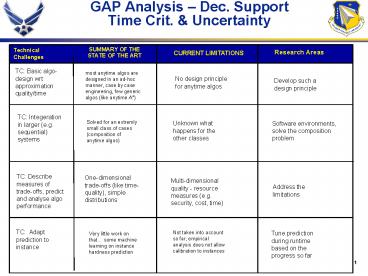GAP Analysis Dec' Support Time Crit' - PowerPoint PPT Presentation
1 / 2
Title:
GAP Analysis Dec' Support Time Crit'
Description:
TC: Basic algo-design wrt approximation quality/time. TC: Describe measures of trade-offs, predict and analyse algo performance ... – PowerPoint PPT presentation
Number of Views:46
Avg rating:3.0/5.0
Title: GAP Analysis Dec' Support Time Crit'
1
GAP Analysis Dec. SupportTime Crit.
Uncertainty
Technical Challenges
SUMMARY OF THE STATE OF THE ART
Research Areas
CURRENT LIMITATIONS
TC Basic algo-design wrt approximation
quality/time
most anytime algos are designed in an ad-hoc
manner, case by case engineering, few generic
algos (like anytime A)
No design principle for anytime algos
Develop such a design principle
TC Integeration in larger (e.g. sequential)
systems
Solved for an extremly small class of cases
(composition of anytime algos)
Software environments, solve the composition
problem
Unknown what happens for the other classes
TC Describe measures of trade-offs, predict and
analyse algo performance
One-dimensional trade-offs (like time-quality),
simple distributions
Multi-dimensional quality - resource measures
(e.g. security, cost, time)
Address the limitations
TC Adapt prediction to instance
Not taken into account so far, empirical analysis
does not allow calibration to instances
Tune prediction during runtime based on the
progress so far
Very little work on that some machine learning
on instance hardness prediction
2
GAP Analysis Dec. SupportTime Crit.
Uncertainty
Technical Challenges
SUMMARY OF THE STATE OF THE ART
Research Areas
CURRENT LIMITATIONS
Framework Model Evaluation (best of breed),
Trade-off of model accuracy and solution quality,
Model Ensembles, Learn when each model works
Human decision, camp of advocacy, models chosen
that can be handled rather than models that are
accurate
No understanding of how simpler models affect
solution quality
Uncertainty Model Accuracy, problem formulation
Types of data, which data needs to be assessed
more accurately to enhance the robustness of
solutions
Computation, computation, computation, little
understanding of identification of critical parts
of the data
repeated solution with slightly varying inputs,
heuristics rather than optimality
Uncertainty Data Accuracy Sensitivity Analysis
Solution quality vs robustness, recovery rather
than best new plan, online scenarios too
pessimistic
Adaptation to long term and short term goals
Recovery rather than best new plan, re-scheduling
and -planning
Uncertainty along a timeline.
Uncertainty Measure the accuracy of the
prediction of quality over time
Measure approximation accuracy over the runtime,
hybrid parallel algorithms, normalization,
dependence of profiles on problem instance
complexity
Time consuming, dependency on computer
architecture
various profiling techniques describing expected
quality, or quality distribution































